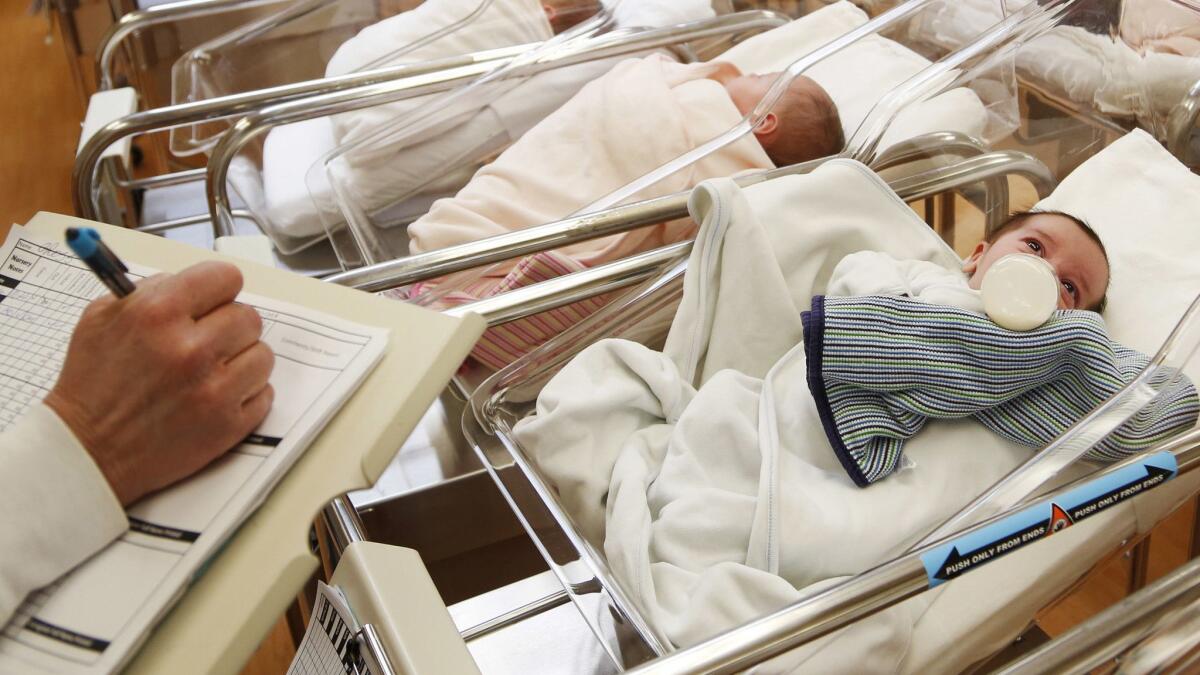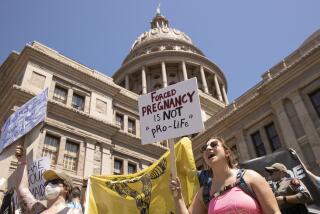America’s baby bust continued in 2018 with record-low birth rates, CDC says

- Share via
Birth rates for American women in their teens and 20s reached record lows in 2018, leading to the fewest babies in 32 years, according to the Centers for Disease Control and Prevention.
In a provisional report released Wednesday, researchers from the CDC’s National Center for Health Statistics said they tallied 3,788,235 births across the country last year. It’s the fourth straight year that the number of births has fallen, and the lowest total since 1986.
The continuing decline came as a surprise to some experts, who had expected the situation to stabilize or reverse given the improving economy.
The total fertility rate was 1,728 births per 1,000 U.S. women in 2018, down 2% from the previous year. Total fertility rate is an age-adjusted estimate of the number of babies a hypothetical group of 1,000 women would have over their lifetimes. When this rate falls below 2,100 births per 1,000 women, it means the current generation isn’t making enough babies to replace itself.
As in past years, the decline was driven by women under 35, the group that produces the most babies. According to the report, the birth rate for women ages 20 to 24 fell 4% to 67.9 births per 1,000; the birth rate for women ages 25 to 29 fell 3% to 95.2 births per 1,000; and the birth rate for women ages 30 to 34 fell 1% to 99.6 births per 1,000.
The teen birth rate last year was 17.4 births per 1,000 adolescent girls and young women ages 15 to 19. That was a 7% drop from 2017 and a new record low for the country.
Meanwhile, the birth rate for women ages 35 to 39 increased 1% to 52.6 births per 1,000, and the birth rate for women ages 40 to 44 rose 2% to 11.8 births per 1,000.
Whether more U.S. women are simply postponing motherhood or forgoing it entirely isn’t yet clear.
But if current trends continue, the country can expect labor shortages in the future, experts said.
“I keep expecting to see the birth rates go up and then they don’t,” said demographer Kenneth M. Johnson of the University of New Hampshire’s Carsey School of Public Policy.
Johnson estimates that if fertility rates hadn’t fallen from their pre-recession levels, an additional 5.7 million babies would have been born in the past decade.
“That’s a lot of empty kindergarten rooms,” he said.
Other experts expressed less concern and predicted that today’s young women will catch up with childbearing later in their lives.
“Our fertility rates are still quite high for a wealthy nation,” said Caroline Sten Hartnett, a demographer at the University of South Carolina.
Young Americans still want to have children, but they don’t feel stable enough to have them yet, said Karen Benjamin Guzzo, who studies families at Bowling Green State University in Ohio.
The U.S. could do more to encourage childbearing with parental leave, childcare subsidies and other policies aimed at helping young adults struggling with student loan debt and housing costs, Guzzo said.
Births were down last year across racial groups, with small declines for Latinos, whites, blacks and Asians. The number of babies born to native Hawaiian and Pacific Islanders was stable.
The rate for preterm births — that is, babies delivered at less than 37 weeks — rose for the fourth straight year to just over 10%. The rate for babies born with a low birth weight — defined as less than 5 pounds, 8 ounces — was just under 8.3%, unchanged from 2017.
The figures in the new report are based on 99.73% of the country’s birth records for 2018, the report said.
The Associated Press was used in compiling this report.






